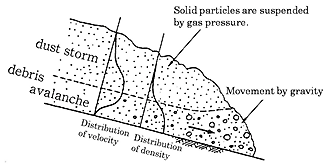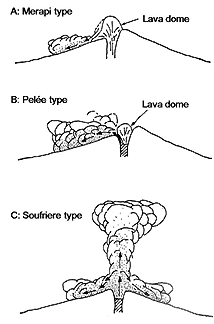A pyroclastic flow refers to a phenomenon in which hot lava pieces, pumices, and ash from a volcanic eruption run down the hillside floating in the generated hot volcanic gas.
In general, the temperature of a pyroclastic flow is as high as 100-1000℃ and its speed is 10-100 m per second or more. A combination of high temperature, high speed, and a large volume of sediment causes severe damage to the flowing areas. Therefore, even among the sediment-related disasters caused by volcanic eruptions, pyroclastic flows are feared as one of the deadliest phenomena that have devastating impacts on both humans and houses. Like other flowing bodies that flow down by gravity, pyroclastic flows flow down topographically low areas, but they easily run over low ridges because their speed is so high.
In terms of the structure, the pyroclastic flow is roughly divided into the lower layer (debris avalanche) and the upper layer (dust storm), a shown in Fig. 1. The lower layer is a dense flow composed of relatively large size sediment. The upper layer is a low-density flow composed of primarily small size volcanic ash that sweeps down the hill floating in the turbulent volcanic gas.
Both the lower and upper layers are high temperature and high speed. The pyroclastic flow was once called a volcanic clastics flow, but the shortened name “pyroclastic flow” is used these days.
In the volcanology, a pyroclastic flow with a bulk volume of 100,000-100 million m3 is called a small-scale pyroclastic flow. As shown in Fig. 2, these small-scale pyroclastic flows are roughly classified into three types by their origin: a) generated by the non-explosive, gravitational collapse of a lava dome (Merapi type), b) generated by the partial fracture and fall of a lava dome due to a volcanic eruption (Pelée type), and c) generated by the fountain collapse of an eruption column after a volcanic eruption (Soufriere type).
*Translated from Journal of Japan Sabo Association, Sabou to Chisui, Vol.81, p.98, 1991

